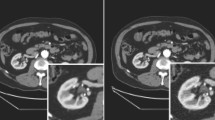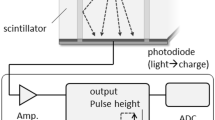Abstract
We developed a deep neural network (DNN) to generate X-ray flat panel detector (FPD) images from digitally reconstructed radiographic (DRR) images. FPD and treatment planning CT images were acquired from patients with prostate and head and neck (H&N) malignancies. The DNN parameters were optimized for FPD image synthesis. The synthetic FPD images’ features were evaluated to compare to the corresponding ground-truth FPD images using mean absolute error (MAE), peak signal-to-noise ratio (PSNR), and structural similarity index measure (SSIM). The image quality of the synthetic FPD image was also compared with that of the DRR image to understand the performance of our DNN. For the prostate cases, the MAE of the synthetic FPD image was improved (= 0.12 ± 0.02) from that of the input DRR image (= 0.35 ± 0.08). The synthetic FPD image showed higher PSNRs (= 16.81 ± 1.54 dB) than those of the DRR image (= 8.74 ± 1.56 dB), while SSIMs for both images (= 0.69) were almost the same. All metrics for the synthetic FPD images of the H&N cases were improved (MAE 0.08 ± 0.03, PSNR 19.40 ± 2.83 dB, and SSIM 0.80 ± 0.04) compared to those for the DRR image (MAE 0.48 ± 0.11, PSNR 5.74 ± 1.63 dB, and SSIM 0.52 ± 0.09). Our DNN successfully generated FPD images from DRR images. This technique would be useful to increase throughput when images from two different modalities are compared by visual inspection.





Similar content being viewed by others
References
Vincent P, Larochelle H, Lajoie I, Bengio Y, Manzagol PA (2010) Stacked Denoising Autoencoders: learning useful representations in a Deep Network with a local Denoising Criterion. J Mach Learn Res 11:3371–3408
Jonathan M, Ueli M, Dan C, Jürgen S (2011) Stacked convolutional auto-encoders for hierarchical feature extraction. International Conference on Artificial Neural Networks. Springer, Heidelberg, pp 52-9
Yang W, Chen Y, Liu Y, Zhong L, Qin G, Lu Z et al (2017) Cascade of multi-scale convolutional neural networks for bone suppression of chest radiographs in gradient domain. Med Image Anal 35:421–433
Dong X, Lei Y, Wang TH, Thomas M, Tang L, Curran WJ et al (2019) Automatic multiorgan segmentation in thorax CT images using U-net-GAN. Med Phys 46:2157–2168
Wang J, Lu J, Qin G, Shen L, Sun Y, Ying H et al (2018) Technical note: a deep learning-based autosegmentation of rectal tumors in MR images. Med Phys 45:2560–2564
Shen CY, Nguyen D, Chen LY, Gonzalez Y, McBeth R, Qin N et al (2020) Operating a treatment planning system using a deep-reinforcement learning-based virtual treatment planner for prostate cancer intensity-modulated radiation therapy treatment planning. Med Phys 47:2329–2336
Liang X, Chen L, Nguyen D, Zhou Z, Gu X, Yang M et al (2019) Generating synthesized computed tomography (CT) from cone-beam computed tomography (CBCT) using CycleGAN for adaptive radiation therapy. Phys Med Biol 64:125002
de Vos BD, Berendsen FF, Viergever MA, Sokooti H, Staring M, Isgum I (2019) A deep learning framework for unsupervised affine and deformable image registration. Med Image Anal 52:128–143
Mori S, Hirai R, Sakata Y (2020) Simulated four-dimensional CT for markerless tumor tracking using a deep learning network with multi-task learning. Phys Med 80:151–158
Hirai R, Sakata Y, Tanizawa A, Mori S (2019) Real-time tumor tracking using fluoroscopic imaging with deep neural network analysis. Phys Med 59:22–29
Takahashi W, Oshikawa S, Mori S (2020) Real-time markerless tumour tracking with patient-specific deep learning using a personalised data generation strategy: proof of concept by phantom study. Br J Radiol 93:20190420
Mori S, Shirai T, Takei Y, Furukawa T, Inaniwa T, Matsuzaki Y et al (2012) Patient handling system for carbon ion beam scanning therapy. J Appl Clin Med Phys 13:3926
Mori S, Kumagai M, Miki K, Fukuhara R, Haneishi H (2015) Development of fast patient position verification software using 2D-3D image registration and its clinical experience. J Radiat Res 56:818–829
Chang Z, Wang Z, Ma J, O’Daniel JC, Kirkpatrick J, Yin FF (2010) 6D image guidance for spinal non-invasive stereotactic body radiation therapy: comparison between ExacTrac X-ray 6D with kilo-voltage cone-beam CT. Radiother Oncol 95:116–121
Penney GP, Weese J, Little JA, Desmedt P, Hill DL, Hawkes DJ (1998) A comparison of similarity measures for use in 2-D-3-D medical image registration. IEEE Trans Med Imaging 17:586–595
Kang E, Min J, Ye JC (2017) A deep convolutional neural network using directional wavelets for low-dose X-ray CT reconstruction. Med Phys 44:e360–e75
Kyong Hwan J, McCann MT, Froustey E, Unser M (2017) Deep convolutional neural network for inverse problems in imaging. IEEE Trans Image Process 26:4509–4522
Gong E, Pauly JM, Wintermark M, Zaharchuk G (2018) Deep learning enables reduced gadolinium dose for contrast-enhanced brain MRI. J Magn Reson Imaging 48:330–340
Chartsias A, Joyce T, Giuffrida MV, Tsaftaris SA (2018) Multimodal MR Synthesis via modality-invariant latent representation. IEEE Trans Med Imaging 37:803–814
Dong X, Lei Y, Wang T, Higgins K, Liu T, Curran WJ et al (2020) Deep learning-based attenuation correction in the absence of structural information for whole-body positron emission tomography imaging. Phys Med Biol 65:055011
Yang J, Park D, Gullberg GT, Seo Y (2019) Joint correction of attenuation and scatter in image space using deep convolutional neural networks for dedicated brain F-18-FDG PET. Phys Med Biol. ;64
Khoo VS, Joon DL (2006) New developments in MRI for target volume delineation in radiotherapy. Br J Radiol 79(Spec No 1):S2–15
Nie D, Trullo R, Lian J, Wang L, Petitjean C, Ruan S et al (2018) Medical Image Synthesis with Deep Convolutional Adversarial Networks. IEEE Trans Biomed Eng 65:2720–2730
Arabi H, Dowling JA, Burgos N, Han X, Greer PB, Koutsouvelis N et al (2018) Comparative study of algorithms for synthetic CT generation from MRI: consequences for MRI-guided radiation planning in the pelvic region. Med Phys 45:5218–5233
Shafai-Erfani G, Lei Y, Liu Y, Wang Y, Wang T, Zhong J et al (2019) MRI-Based Proton Treatment Planning for Base of Skull Tumors. Int J Part Ther 6:12–25
McKenzie EM, Santhanam A, Ruan D, O’Connor D, Cao M, Sheng K (2020) Multimodality image registration in the head-and-neck using a deep learning-derived synthetic CT as a bridge. Med Phys 47:1094–1104
Lei Y, Dong X, Tian Z, Liu Y, Tian S, Wang T et al (2020) CT prostate segmentation based on synthetic MRI-aided deep attention fully convolution network. Med Phys 47:530–540
Dong X, Wang T, Lei Y, Higgins K, Liu T, Curran WJ et al (2019) Synthetic CT generation from non-attenuation corrected PET images for whole-body PET imaging. Phys Med Biol 64:215016
Landry G, Hansen D, Kamp F, Li M, Hoyle B, Weller J et al (2019) Comparing unet training with three different datasets to correct CBCT images for prostate radiotherapy dose calculations. Phys Med Biol 64:035011
Yuan N, Dyer B, Rao S, Chen Q, Benedict S, Shang L et al (2020) Convolutional neural network enhancement of fast-scan low-dose cone-beam CT images for head and neck radiotherapy. Phys Med Biol 65:035003
Kim J, Lee JK, Lee KM (2016) Accurateimagesuper-resolutionusing very deep convolutional networks. IEEE Conference on Computer Vision and Pattern Recognition
Papadakis AE, Perisinakis K, Oikonomou I, Damilakis J (2011) Automatic exposure control in pediatric and adult computed tomography examinations: can we estimate organ and effective dose from mean MAS reduction? Invest Radiol 46:654–662
Mori S, Inaniwa T, Kumagai M, Kuwae T, Matsuzaki Y, Furukawa T et al (2012) Development of digital reconstructed radiography software at new treatment facility for carbon-ion beam scanning of National Institute of Radiological Sciences. Australas Phys Eng Sci Med 35:221–229
Vasiliadis G, Antonatos S, Polychronakis M, Markatos E, Gnort IS (2008) High Performance Network Intrusion Detection Using Graphics Processors. Proceedings of the 11th International Symposium on Recent Advances in Intrusion Detection (RAID), pp 116–34
Mori S, Shibayama K, Tanimoto K, Kumagai M, Matsuzaki Y, Furukawa T et al (2012) First clinical experience in carbon ion scanning beam therapy: retrospective analysis of patient positional accuracy. J Radiat Res 53:760–768
Badrinarayanan V, Kendall A, Cipolla R (2017) SegNet: A deep Convolutional Encoder-Decoder Architecture for Image Segmentation. IEEE Trans Pattern Anal Mach Intell 39:2481–2495
Ulyanov D, Vedaldi A, Lempitsky VS (2016) Instance normalization: the missing ingredient for fast stylization. ArXiv. ;abs/1607.08022.
Srivastava N, Hinton G, Krizhevsky A, Sutskever I, Salakhutdinov N (2014) Dropout: A simple way to prevent neural networks from overfitting. J Mach Learn Res 15:1929–1958
Sergey I, Christian S (2015) Batch Normalization: Accelerating Deep Network Training by Reducing Internal Covariate Shift. The 32nd International Conference on Machine Learning. :448 – 56
Ronneberger O, Fischer P, Brox T (2015) U-Net: Convolutional Networks for Biomedical Image Segmentation. Medical Image Computing and Computer-Assisted intervention (MICCAI). Springer, Munich, pp 234–241
Radford A, Metz L, Chintala S (2015) Unsupervised Representation Learning with Deep Convolutional Generative Adversarial Networks. arXiv:150806576.
Hwang D, Kim KY, Kang SK, Seo S, Paeng JC, Lee DS et al (2018) Improving the Accuracy of simultaneously reconstructed activity and attenuation maps using deep learning. J Nucl Med 59:1624–1629
Simonya K, Zisserman A (2015) Very deep convolutional networks for large-scale image recognition. International Conference for Learning Representations
Wang Z, Bovik AC, Sheikh HR, Simoncelli EP (2004) Image quality assessment: from error visibility to structural similarity. IEEE Trans Image Process 13:600–612
Yochai B, Tomer M (2018) The Perception-Distortion Tradeoff. Proceedings of the IEEE Conference on Computer Vision and Pattern Recognition (CVPR), pp 228-37
Emami H, Dong M, Nejad-Davarani SP, Glide-Hurst CK (2018) Generating synthetic CTs from magnetic resonance images using generative adversarial networks. Med Phys.
Sakata Y, Hirai R, Kobuna K, Tanizawa A, Mori S (2020) A machine learning-based real-time tumor tracking system for fluoroscopic gating of lung radiotherapy. Phys Med Biol 65:085014
Acknowledgements
We wish to thank the staff of the Medical Physics Department of the National Institutes for Quantum Science and Technology, and of our institute hospitals, for their support and discussion. We thank Libby Cone, MD, MA, from DMC Corp. (www.dmed.co.jp) for editing drafts of this manuscript.
Funding
None.
Author information
Authors and Affiliations
Corresponding author
Ethics declarations
Conflict of interest
Drs. Hirai and Sakata are employed by the Toshiba Corporation, Kawasaki, Japan.
Ethical approval
The study was approved by the Institutional Review Board of our institution (N21-001).
Additional information
Publisher’s Note
Springer Nature remains neutral with regard to jurisdictional claims in published maps and institutional affiliations.
Rights and permissions
Springer Nature or its licensor (e.g. a society or other partner) holds exclusive rights to this article under a publishing agreement with the author(s) or other rightsholder(s); author self-archiving of the accepted manuscript version of this article is solely governed by the terms of such publishing agreement and applicable law.
About this article
Cite this article
Mori, S., Hirai, R., Sakata, Y. et al. Deep neural network-based synthetic image digital fluoroscopy using digitally reconstructed tomography. Phys Eng Sci Med 46, 1227–1237 (2023). https://doi.org/10.1007/s13246-023-01290-z
Received:
Accepted:
Published:
Issue Date:
DOI: https://doi.org/10.1007/s13246-023-01290-z




